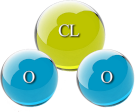Snake bite of a lance viper (Paraguay) in a dog
The venom of the lance viper (Bothrops asper) is known for its high toxicity, primarily due to the presence of potent enzymes and proteins that can cause severe tissue damage and disrupt blood coagulation. Compared to other snake species, such as the eastern diamondback rattlesnake or the black mamba, the lance viper's venom is particularly harmful in terms of necrosis and hemorrhage. While some snakes may have neurotoxic venoms that primarily affect the nervous system, the lance viper's venom is more cytotoxic, leading to painful bites and significant local effects. This makes it one of the more dangerous snakes in its habitat, and is usually deadly for dogs.
Snake bite of a lance viper (Paraguay) in a dog

By Frizzi
First of all, a big thank you to everyone who supported us mentally and with practical tips during this time!From time to time there was contradictory advice and also different opinions „here in the house“ as to how to proceed with treatment at time X. This made it all the more important to reconcile knowledge and intuition. I did not make an exact record of the measures taken, but I will try to reconstruct the process as best I can.
All in all, the treatment was suboptimal in terms of timing – just like in real life – but nevertheless successful. We mainly used CDS and MMS1/CD as well as DMSO. We used sprays, lubricants, oral and rectal infusions and intravenous infusions
HOW IT ALL BEGAN…
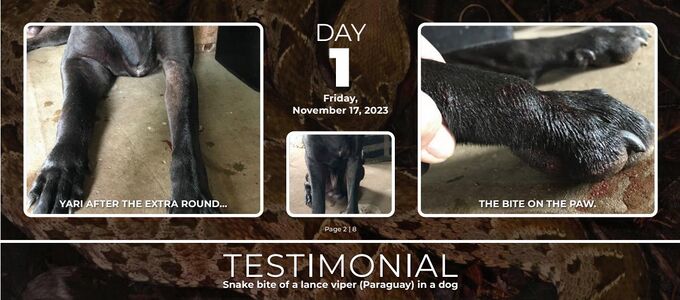
Yari and Nuna are out in the mornings for a walk – like most of the dogs here in Paraguay. After about two hours they returned and lay down outside with me. It
was only after about half an hour that I realized that Yari had bleeding spots all over her body and that the joint of her right paw was very swollen. So I brought
him inside and treated the wound with CDS spray (0.3%) – and I continued with what I was doing before. After quite a while I noticed that the wounds did not stop bleeding – rather the opposite – and that the leg continued to swell upwards and was red in color. That was the moment I realized that he had been bitten by snake – at first it was un - clear which one – but the suspicion that it was a yarará, At that point, he was already very weak.
I immediately called in my partner and he made a 10 ml syringe with CD or CDS for rectal application. None of us can say exactly how it was diluted neither of us can say anymore, but it was certainly a good portion. A few minutes later the procedure was repeated. We also gave him oral with the syringe CD or CDS. I can no longer say what we used at that moment – we just acted…
After that, Yari announced that he had to pass stool. Unprepared, as we were, we went out with him without putting him on the lead and without putting Nuna on a lead. The lady asked him to go for a walk – and they were gone … while our mouths were open. After about two hours, they both turned up again and Yari’s swellings had enlarged, as you can see in the picture below. I continued with the rectal administration – every 20 to 30 minutes with CDS (approx. 1,000 ppm) – until late in the evening. I also sprayed the wounds with CDS.
RECTAL INFUSIONS AND CALLING FOR HELP ON THE SPOT
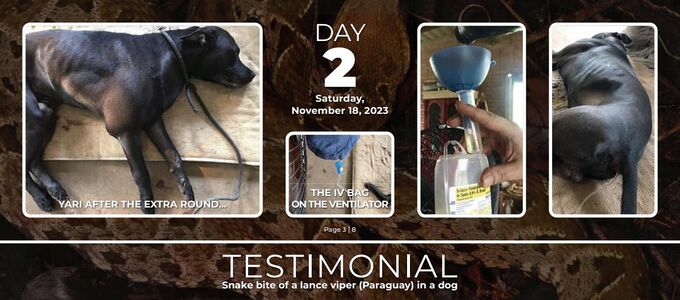
The next morning, we quickly continued with the rectal injections and quickly agreed to continue with the rectal infusion instead – somewhere in the region of 35 ml CDS or 35 activated drops to 500 ml isotonic saline solution that we had prepared ourselves with natural salt. The dosage came intuitively and was based on „better too much than too little“. When this was running, I activated my contacts here locally – an acquaintance who already had a lot of experience in treating snakebites with CDS and DMSO and a friend who has already administered many infusions, at least in humans. The former reported on the third day. The other was also only able to come to us the following day. So we continued with the rectal infusions and the injection into the mouth – plus NaClO2 in the drinking water. We treated the wounds that were still bleeding with CDS and DMSO. Apparently there was a second bite on the shoulder.
DEHYDRATION – AND NOW?
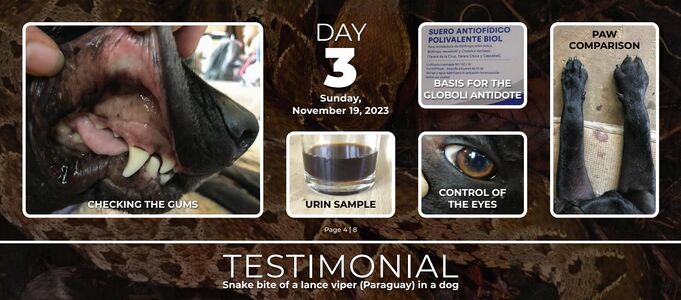
Two days had passed since the bite and the hope was very high that the first IV would be running soon. The friend got in touch and advised me to have the first liter of Ringer’s solution with 10 ml DMSO via IV as soon as possible. So just a little patience, a few phone calls with the other friend, who wanted to get everything she needed on the way and then set up the access. The idea was a good one, but in our inexperience we didn’t expect that the blood had become so „unmanageable“ in the meantime due to dehydration that it just wouldn't flow out of the freshly inserted cannula. And we learned that where nothing flows out, nothing flows in. So we quickly passed the message on to our friend. She: „To the vet immediately! The dog is dehydrated!“ So much for the theory – in practice, we don’t have a car and the friend unfortunately had to go back to her farm to look after her animals. What she could do was to give Yari the antidote homeopathically. She had recently prepared the D1 globoli herself, as her dog had also been bitten by the Bothrops. So she tested with her tensor whether the remedy was the right one and then how much he should be given. So she put three globules in his cheek pocket and the first reactions were a kind of shaking of the head. Then we quickly sent a message to the veterinary practice – which, incidentally, works closely with our friend so that our way of working with chlorine dioxide and DMSO could not meet with any resistance. That’s quite something! Unfortunately, however, on this day – a Sunday – no one was able to come to us. So we arranged to meet on Monday morning. We spent the rest of the day administering as much fluid as possible via rectal infusion – with chlorine dioxide, of course – as we did on the second day. The friend also told us to take photos of the urine, gums and eyes
THE FIRST IV
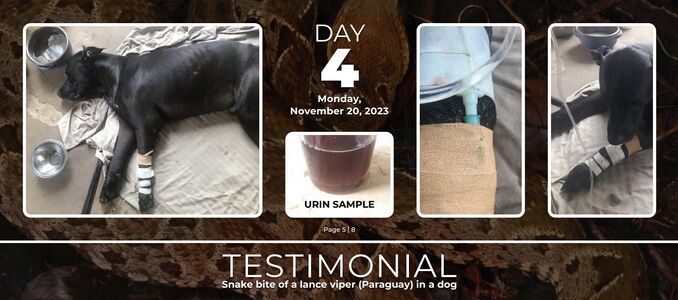
...I won’t mention that all the wounds were also treated with CDS and DMSO – that goes without saying. Early in the morning, the first thing to do was to take the quad bike to a larger town, to organize everything that was missing in sufficient quantities. After five pharmacies I had enough Ringer’s solution, glucose solution, indwelling cannulas in various sizes and a tourniquet. So off to the meeting point with the vet – here in the sticks the streets have no names or house numbers. Once we arrived home, the doctor got to work and set up the access. The blood wasn’t really common, but it was better than at the lecture, so he used a few tricks to get the first IV running: 1 liter of Ringer’s solution, 10 ml of DMSO and 5 ml of 5% glucose solution. He also brought iron + folic acid pellets, so that the formation of new blood could be given a boost.
The instructions from the friend were to let the liter run in for two hours and then the next liter (but then without DMSO) in two hours as well, as Yari was still very dehydrated. In the afternoon, I got back on the quad bike to visit another friend with a farm to get beef bones, fresh goat’s milk and eggs. We have chickens ourselves, but they don’t always lay equally well. She also had some zeolite ready for me as we didn't have any left ourselves. In the picture below you can see how the red-colored swellings have spread to the chest-abdominal area. Whether and to what extent the kidneys were affected only be determined by the color of the urine and time will tell. The same applies to the liver, which at least in the acute state indicated an overload. But the IV was running, the bone broth was simmering away and we were reasonably satisfied
LIVER ON STRIKE – CDS FROM THE „FRONT“ AND BACK
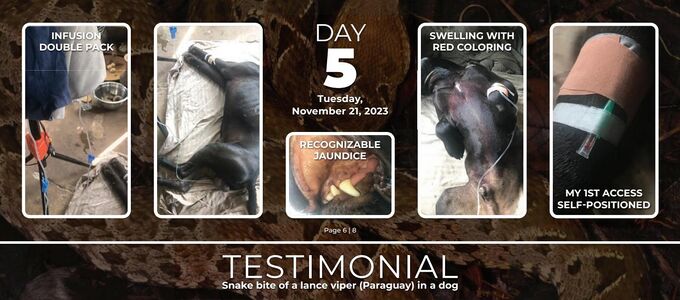
Now that an access had finally been established, I was particularly keen to administer to administer CDI (CDS-IV). Our friend advised DMSO, but we decided to apply the knowledge we had learned from Andreas – out of conviction! So I got the NaCl infusion solution (500 ml) from the pantry and first added 2.5 ml lidocaine to it. I had already tested the product for compatibility with CDS a few weeks earlier. I then added 6 ml of my pickle jar CDS and carried out the blink test, as I do not have any PH measuring devices. I simply put a drop of the mixture into my eye If this is pleasant, you can assume that the mixture is compatible with the veins. Of course, this is not professional, but in emergency situations quite feasible. I didn’t feel it was quite right yet and added 0.5 ml bicarbonate solution for injection (8.4 %) and repeated the test. Now I found the solution perfect and ran it at about 20 drops/minute. In view of the fact that the kidneys and liver did not look so good, we ran the rectal infusion in parallel, as we had learned from Andreas that this is the most direct way to reach the kidneys and liver. So now everything was running smoothly and we „only“ had to make sure that all the tubes stayed where they belonged. Incidentally, the whole thing is not a one-man job. Being two is the minimum – and you can forget about working for a good week. At this point, a big thank you to my partner! In the late afternoon – after a short break with low-fat bone broth I wanted to run the next IV and realized that the flexible cannula was kinked and could no longer be used. That was the moment I decided to insert my first IV myself. Theoretically, I knew the most important things as I wanted to learn how to do it anyway and it worked straight away. I was a little proud of myself…
AND ANOTHER SETBACK…
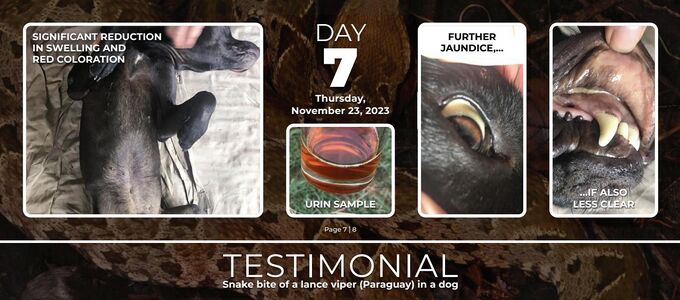
I can’t say much about day six. We continued with CDI and rectal infusions, but one after the other. That’s why I’ll continue right here with day seven. Our friend was not enthusiastic at all about the pictures of the urine, eyes and gums – we, on the other hand, were in good spirits as an improvement was clearly recognizable.
So we carried on at the same pace – getting the CDI ready. And then the sobering realization, that all previous CDIs seemed to run into him without CDS. It seemed day six that I couldn’t see any yellowing of the mixture, so this time I paid particular attention to it – and indeed – when I added the bicarbonate, the typical CDS coloration immediately disappeared! I had never heard of this before and therefore didn’t pay attention to it. So I wrote to Andreas and Rama at the same time and asked whether I could also run the IV with lidocaine and CDS and was given the green light very quickly. So I started all over again and then it finally ran – the first real CDI.
We felt that it had a fantastic effect – Yari became much more agile – what a blessing! But it also required more attention on our part – we had to react immediately to Yari’s every movement, we had to react immediately to ensure that every thing stayed in place. After the CDI, we ran the rectal infusion again. Oh yes – on day six I met with our vet to pick up a special Boldo extract that our friend developed in collaboration with a university in Germany. Boldo is a poisonous plant and a preparation was developed that contains as little poison as possible and as much boldin as possible. He was given 20 drops of this every eight hours. Boldin acts on the liver via the bile – that's all I know about it.
IT’S RUNNING…
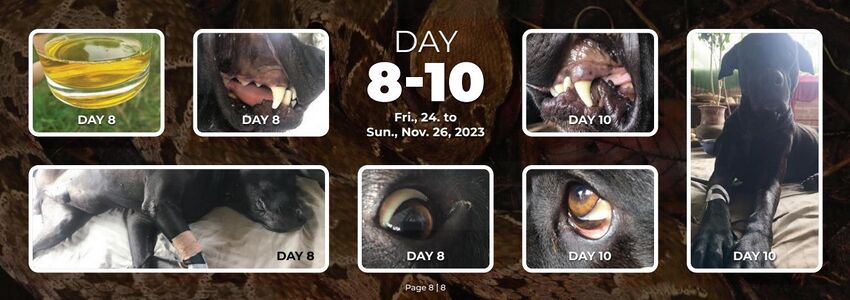
…bit by bit and every day it got visibly better. The urine clearly showed that the kidneys were working and the discoloration of the eyes and gums. He was fed a light diet of boiled potatoes, carrots and beet – The addition of bone broth made it even tastier. Raw eggs (quail and chicken) and goat’s milk were also added. Beef liver, kidneys, rumen and tripe were also added to the diet. and the amount has been increased daily since then. Ground milk thistle seeds – even pure.
Today is Thursday, November 30th. He is given CDS orally and 1-2 hours per day the rectal infusion runs again. Boldo extract and zeolite are part of his daily routine. The eyes are normal – the gums almost…A small final word: Despite the many small setbacks, the result is fantastic! No matter what you are going through personally – don’t give up and learn how to deal with chlorine dioxide. Create networks online and regionally „in real life“. And – especially in challenging times – avoid the voices of the doubters. For example, I only told my parents about it when Yari was over the mountain, as I was aware that I didn’t have the energy for „slogans“ at the moment.
We, my partner and I, were certain at all times that our approach would be successful – and that is essential – especially for the patient. In the case of snake bites (and bites from other animals and poisoning in general, for example), the most important thing is to remain calm and pass this on to the victim. Knowledge, experience, intuition and sensible equipment make the situation considerably easier…
Telegram contact for questions: @frizzicato
